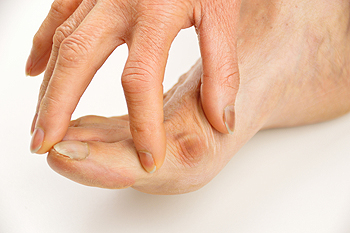 Joint pain can accompany the medical condition that is known as a bunion, which is defined as a bony protrusion that develops on the side of the big toe and pushes the other toes toward each other. Common reasons bunions can develop can include genetic factors, and from wearing shoes that do not have adequate room for the toes to move freely in. Additionally, there may be existing medical conditions that can cause bunions to form, including certain types of arthritis, and poor foot function. It is beneficial to wear larger shoes that can accommodate the bunion, and patients may choose to wear a protective covering over it. If you are afflicted with a bunion, it is strongly suggested that you are under the care of a podiatrist who can recommend treatment options, which may include surgery for permanent removal.
Joint pain can accompany the medical condition that is known as a bunion, which is defined as a bony protrusion that develops on the side of the big toe and pushes the other toes toward each other. Common reasons bunions can develop can include genetic factors, and from wearing shoes that do not have adequate room for the toes to move freely in. Additionally, there may be existing medical conditions that can cause bunions to form, including certain types of arthritis, and poor foot function. It is beneficial to wear larger shoes that can accommodate the bunion, and patients may choose to wear a protective covering over it. If you are afflicted with a bunion, it is strongly suggested that you are under the care of a podiatrist who can recommend treatment options, which may include surgery for permanent removal.
If you are suffering from bunion pain, contact one of our podiatrists of Family Foot Care of Long Island. Our doctors can provide the care you need to keep you pain-free and on your feet.
What Is a Bunion?
Bunions are painful bony bumps that usually develop on the inside of the foot at the joint of the big toe. As the deformity increases over time, it may become painful to walk and wear shoes. Women are more likely to exacerbate existing bunions since they often wear tight, narrow shoes that shift their toes together. Bunion pain can be relieved by wearing wider shoes with enough room for the toes.
Causes
- Genetics – some people inherit feet that are more prone to bunion development
- Inflammatory Conditions - rheumatoid arthritis and polio may cause bunion development
Symptoms
- Redness and inflammation
- Pain and tenderness
- Callus or corns on the bump
- Restricted motion in the big toe
In order to diagnose your bunion, your podiatrist may ask about your medical history, symptoms, and general health. Your doctor might also order an x-ray to take a closer look at your feet. Nonsurgical treatment options include orthotics, padding, icing, changes in footwear, and medication. If nonsurgical treatments don’t alleviate your bunion pain, surgery may be necessary.
If you have any questions, please feel free to contact our office located in Port Jefferson Station, NY . We offer the newest diagnostic and treatment technologies for all your foot care needs.
